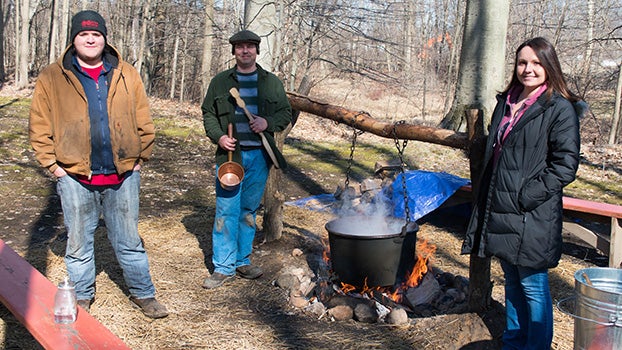Pokagon Band invites community to take part in sugar bush season
Published 10:13 am Wednesday, March 20, 2019

- From left, Wahsnoday Pamp, Jefferson Ballew IV, both sugar leads, and Nicole Holloway, a cultural activities coordinator, stand near a pot of sap Tuesday on Pokagon grounds. Using this method to evaporate water from sap to reduce it into syrup is a traditional native way to make maple syrup. (Leader photos/EMILY SOBECKI)
DOWAGIAC — Above a boiling vat of maple sap, a vapor cloud carrying the sweet scent of syrup in the making billowed thickly as Jefferson Ballew IV and Wahsnoday Pamp, both sugar bush leads, tended to the evaporator Tuesday.
The process – and tantalizing scent – is one of many steps and senses that people can take in when they visit the Pokagon Band of Potawatomi Indians’ sugar camp to learn about the tribe’s Sugar Bush season. The camp is located behind the administration building at 58620 Sink Road in Dowagiac.
Throughout Sugar Bush season, natives teach the community about a contemporary way for making maple syrup, based on the Indigenous process. Visiting the sugar camp is free and open to the public. Those looking for a taste can purchase maple syrup that is bottled and sold in the tribe’s gift shop. In the weeks to come, there will also be maple candies for people to enjoy.
Looking out over the forest Tuesday, a number of the trees were affixed with pale green buckets. Sap clear as water dripped into the pails, where it would then be transferred to an evaporator and boiled down into amber-colored syrup. The tribal process does not utilize tubes, which are commonly seen in the process, to drain sap from the trees. The sap would also be manually stirred in the evaporator, rather than automated. Still, Ballew said, today’s process is not exactly like the one his ancestors used – though the importance of the tradition and its lessons remain the same.
“First of all, there would be a female [leading the process] because they are the heads of our state,” Ballew said. “They are the heads of our household and the ones that make the laws in our village. Us men, we only set sugar camp up.”
A more traditional evaporator that consists of a pot of sap brewing on a fire can be viewed at the sugar camp. It is tended to by two women who stoke the fire and watch over the liquid.
For the Pokagon Band, the sap collection process has historically been more important for creating sugar than syrup.
“We would have preserved our meat, vegetables and our fruit in that sugar,” Ballew said. “They were also capable of making vinegar with that preserve.”
In addition to sharing the tradition with the community, the Sugar Bush season teaches tribal lessons that seek to convey the importance of respecting and preserving nature.
“This is a spiritual belief. This is part of our creation story and why human beings and trees get along so well,” Ballew said. “For one, we breathe their exhale and they breathe our exhale. We can’t live without them and they without us.”
Every aspect of the sap is used in the process so that nothing goes to waste. Even the foam created from the boiling sap is skimmed off the liquid’s surface and saved to use as a caking agent in baking products.
Nicole Holloway, the cultural activities coordinator, said sugar bush season begins and ends depending on the weather.
While traditionally March has been the best time to harvest sap, climate change has played a role in the start and end of the season, sometimes bumping up the beginning of sap collection to February. This year, Holloway said the season had followed more traditional trends and kick-started in March.
“March has been crazy busy out here,” Holloway said. “We pulled in more than 400 gallons of sap yesterday. What you need for the sap to flow is below freezing temperatures in the evenings and above freezing temperatures during the day.”
Cold temperatures are vital to creating the sap. This year’s Polar Vortex that hit the area early this year helped to provide necessary cold for the process, Holloway said.
The tribe shares the Sugar Bush season with a number of local schools, including Dowagiac Union High School and preschoolers from the Zagbëgon early learning and development academy.
“They get to learn about the process, collect the sap,” Holloway said. “They watch the evaporator and get a little science information about what the machine does.”
Ballew said there are many valuable lessons to be gained from the Sugar Bush season.
“Remember, energy never ceases to exist. It transfers from one form to another,” Ballew said. “So, we are able to show that to our kids and teach them about science and the transfer of energy from the ground to the wood to the fire to the metal to the water to the steam.”
Kyla Carneiro, the communication specialist, encouraged anyone from the community to visit the grounds and learn about the Sugar Bush season.
“The Pokagon band was here first tapping these trees,” Carneiro said. “Modern culture is built on what they started. And, it’s delicious.”






